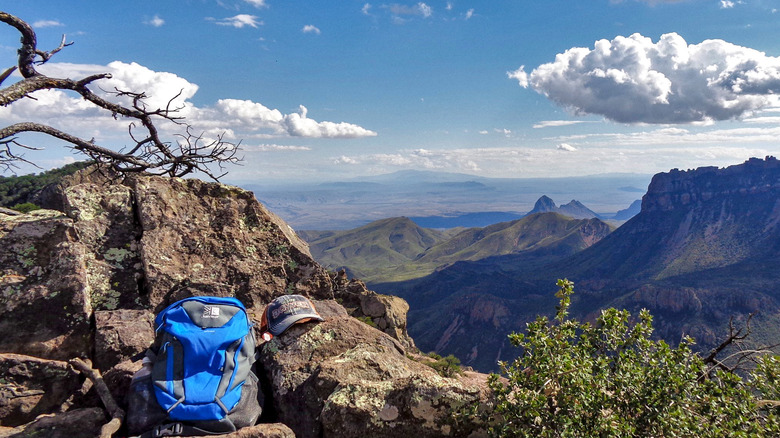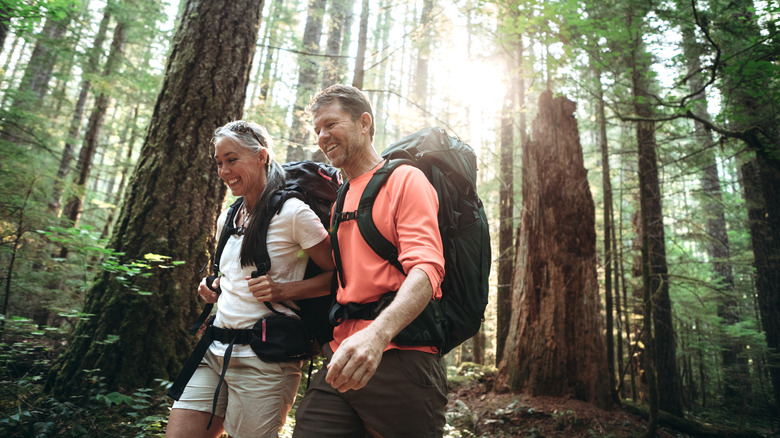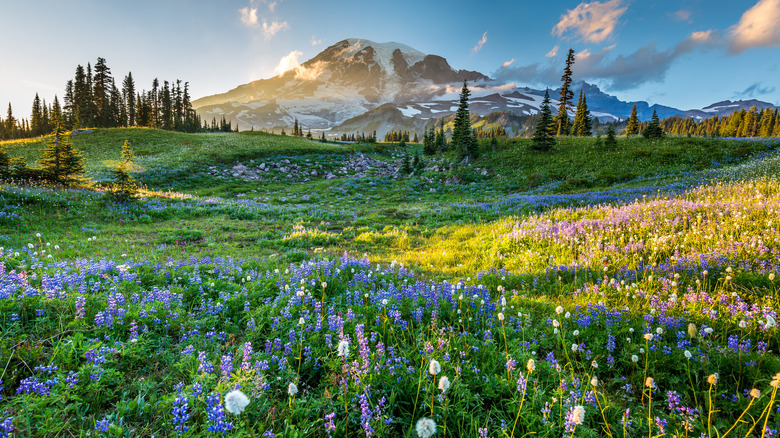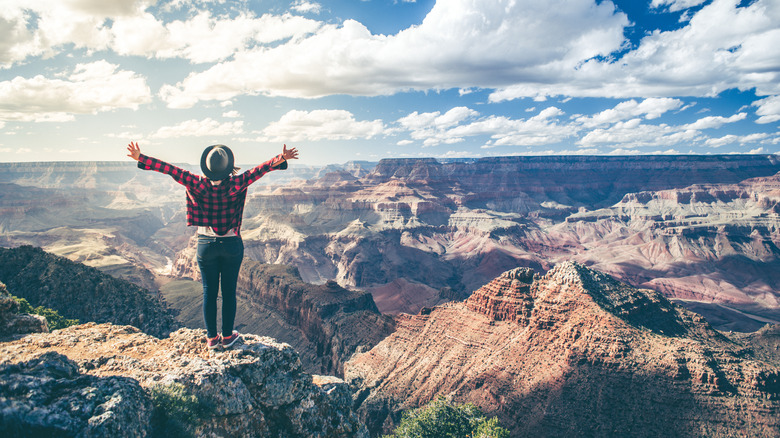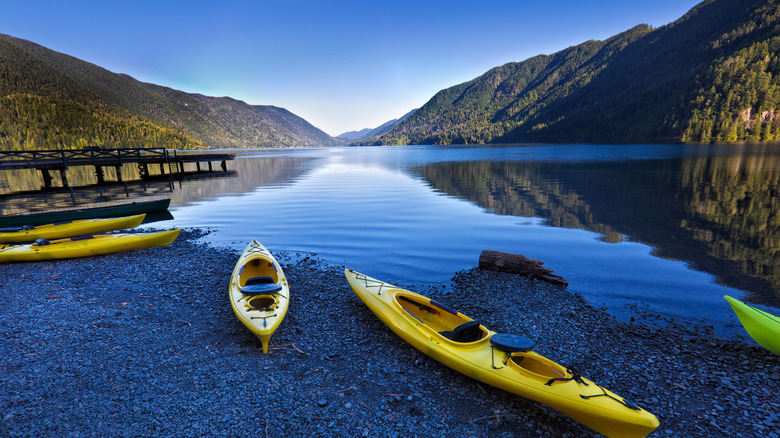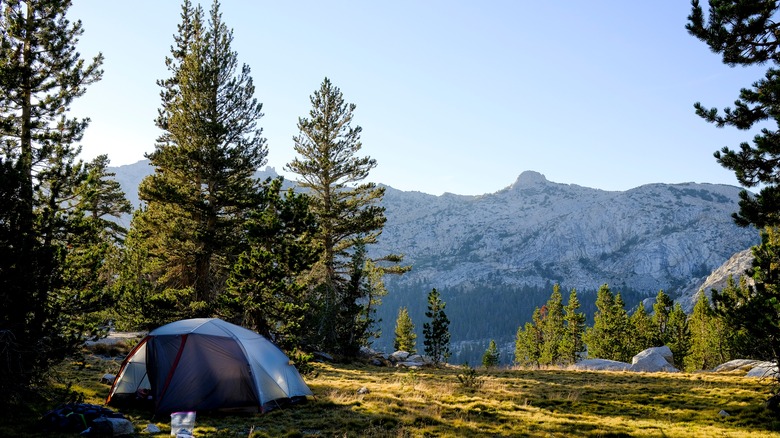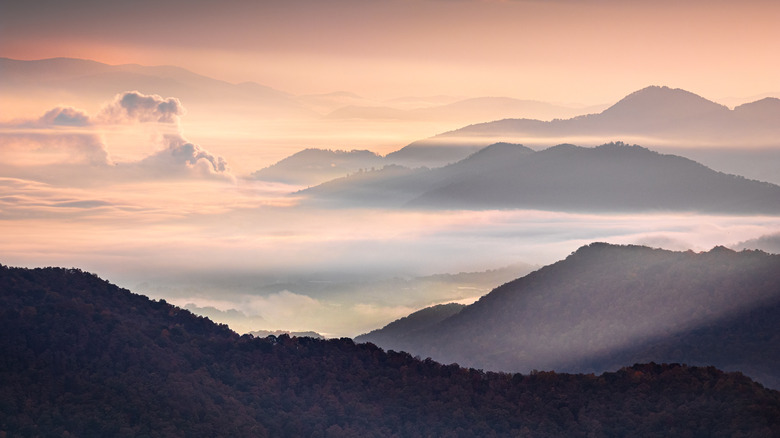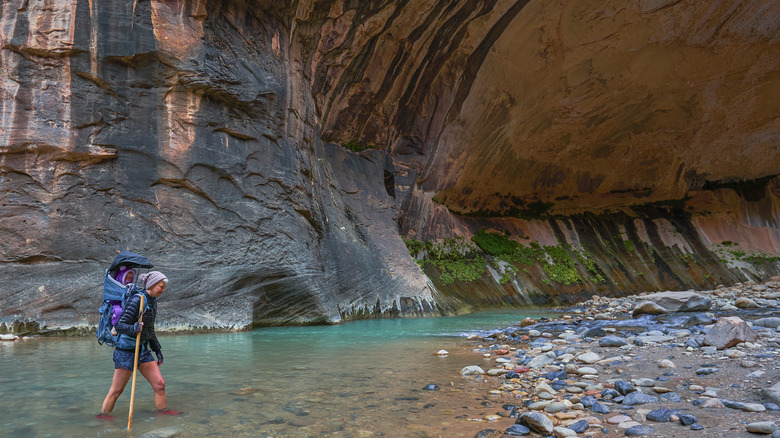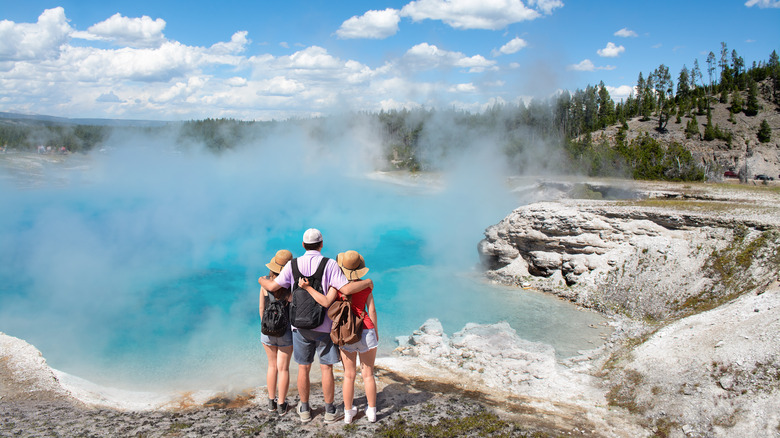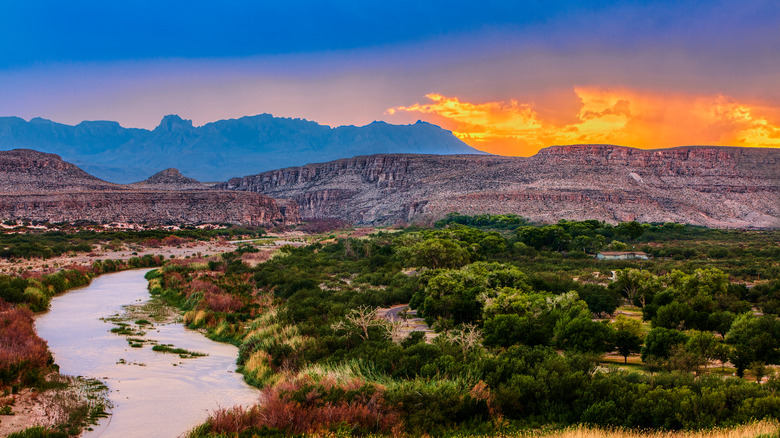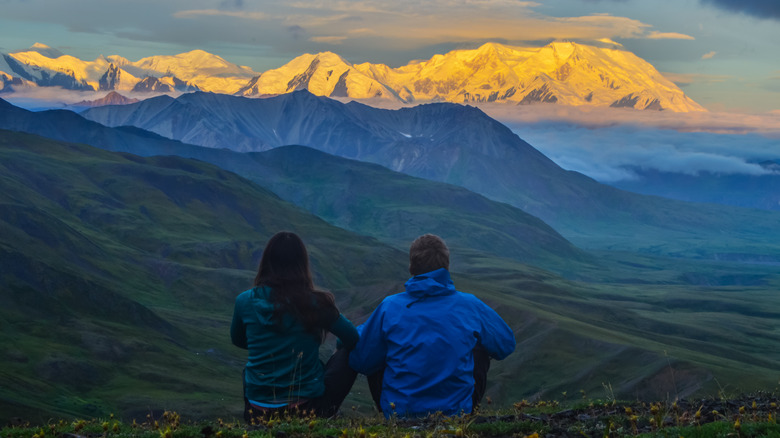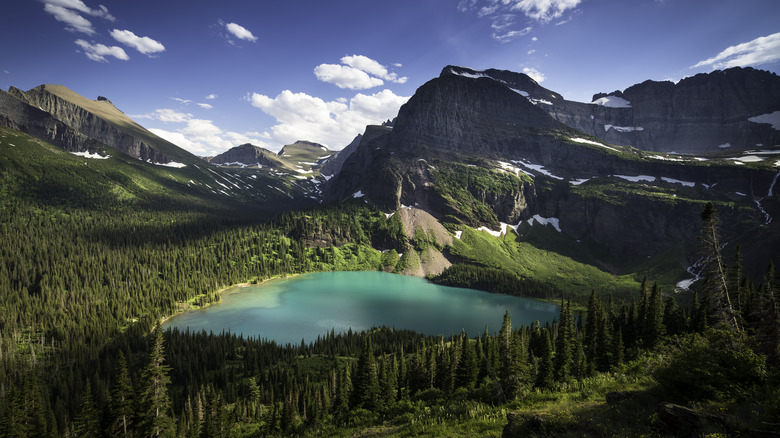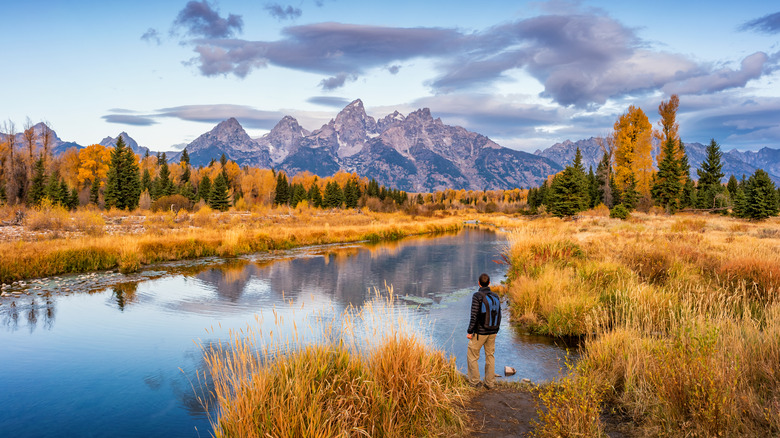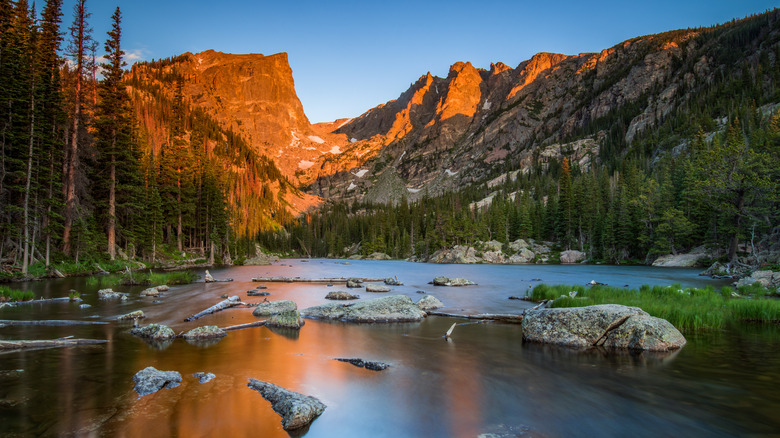The 12 Best US National Parks For Your Next Backpacking Adventure
With over 420 national parks in the U.S., there is definitely an abundance of adventure awaiting backpackers and avid nature lovers. Of course, whether you want to enjoy some first-class backcountry camping, take your hiking expertise to the next level, or just appreciate nature and unplug from it all, there is undoubtedly a true wanderer's experience beyond each and every park entrance. From the rugged desert, coastal, and forested landscapes to picturesque valleys, towering mountain ranges, pristine bodies of water, and great canyons, it is undeniable that backpacking in any of the U.S.'s many protected wilderness areas is honestly a pleasure trip.
Still, with ample ground to cover and countless otherworldly wonders to discover across the nation, choosing one outdoorsy haven over another can be difficult. What's more, deciding where to start your alfresco adventure if you have never gone backpacking before can be a bit tricky. So, to make planning your next multi-day excursion into the wild a little easier, here are 12 of the best U.S. national park sites to consider for your next backpacking getaway.
Backpacking tips
If this is your first time considering such an adventure, then there are a handful of important tidbits to keep in mind. For instance, nature explorers should choose a particular destination or, in this case, a national park that is both convenient and in line with everyone's experience level in the group. It is also important to remember that backpacking in most national parks does require a permit — more specifically, a backcountry permit and sometimes even a hiking permit, along with car reservations (if applicable).
Some national parks offer last-minute or day-hike permits if you decide on an impromptu backpacking adventure. But, it is highly recommended that you plan out all aspects of your outdoorsy getaway well in advance, as permits generally tend to go quickly, especially during peak season. Besides all this, backpackers need to take into account the weather, have a well-thought-out itinerary, make it a point to thoroughly understand the park rules, have gear/equipment that works, and pack the essentials (food, water, a first-aid kit, and layer-friendly clothing — just to name a few).
Mount Rainier National Park
Wanderers will find Mount Rainier National Park in the gorgeous state of Washington. Touted as next-level, this popular outdoor space is teeming with stunning scenery, iconic hiking trails, ample activities, a volcano to explore (Mount Rainier), and a wealth of backpacker-friendly accommodations. As a whole, Mount Rainier National Park is an excellent choice for all experience levels, though it is not a walk in the park by any means. That said, trails such as the Wonderland Trail, a 93-mile excursion, are moderate to challenging but not impossible to complete.
Of course, besides trails, parkgoers can enjoy one-of-a-kind views of wildlife, forested land, flower-filled meadows, valleys, glaciers, waterfalls, Mount Rainier itself, and the surrounding picturesque mountainscape. Of course, Wonderland Trail hikers will need to spend a few days in the park and, therefore, must obtain a wilderness pass for a multi-day stay in the backcountry (note that all overnight stays need a permit and are available on a first-come-first-served basis up to two days in advance). And if you plan on climbing above 10,000 feet while immersing yourself in this vast 236,380-acre park, then a climbing pass is also required. However, it is worth mentioning that day hikes in Mount Rainier National Park do not warrant a permit.
Grand Canyon National Park
From whitewater rafting and horseback riding to hiking, the Grand Canyon National Park, in Arizona, is legendary and truly a sight to behold. Not only is the Grand Canyon a World Heritage Site, but it is also a place like no other on Earth, with the canyon itself dating back over two billion years. So backpackers are in for a real treat here. This national park is approximately 1.2 million acres, and there are more than a few backpacking adventures to take, like Havasupai Waterfalls (a 4-day, 27-mile, moderate trail) and the iconic Rim-to-Rim route (a 4-day, 24-mile, moderate trek) — just to name a few.
Plus, with a plethora of camping options, DIY adventure planning assistance, guided activities, and incredible views, the Grand Canyon National Park is undoubtedly a must. And speaking of camping, a backcountry permit is not required if you opt to set up camp in the developed North Rim or South Rim campgrounds (Desert View or Mather campground). Backpackers also don't need to apply for a single day or night hike pass here either. However, if your plans do include accommodations and multi-day excursions, then make sure you apply for a backcountry permit well in advance (typically five months prior to your trip).
Olympic National Park
Only a few hours from Seattle, Washington, adventurers will find Olympic National Park. This national gem is brimming with activities, beautiful beaches like LaPush, Shi Shi, and Ruby Beach, snow-capped mountain peaks, glaciers, Mount Olympus, and over 922,650 acres of outdoorsy goodness. Olympic National Park actually ranks high in the list of the most visited U.S. parks, so there is definitely something to this particular wilderness area.
A few other reasons to check out this phenomenal national park include its diverse wildlife, distinct rainforests (the Queets, Quinault, and Hoh Rainforests), several hundred miles of hiking trails, as well as Olympic National Park's abundance of lakes, rivers, and waterfalls. What's more, backpackers on their own pilgrimage or anyone looking to go off-grid can check out the One Square Inch of Silence. The One Square Inch of Silence is located in Olympic National Park's Hoh Rain Forest and is as majestic as it is fascinating. That said, don't forget to get your wilderness/backcountry permit early (available six months in advance on a rolling basis) for your multi-day outing in this marvel.
Yosemite National Park
First-rate stargazing, hiking, and wildlife-watching are what backpackers can expect when they head to Yosemite National Park. But that's not all that awaits backcountry explorers in this 1,200 square-mile wonderland tucked away in California's Sierra Nevada Mountains. With cascading waterfalls, towering sequoia trees, stellar rock climbing, and 800-plus miles of hiking trails, Yosemite National Park is another top U.S. place of interest. Attracting countless visitors annually, this national treasure is one of America's first conservation efforts and is home to some downright incredible sights.
A few must-see spots in Yosemite National Park include the famous El Capitan, the Half Dome, and Bridalveil Fall — all of which can easily be seen from Tunnel View. Popular hiking trails like the Mist Trail, Tuolumne Grove Trail, and Tenaya Lake are also beyond picturesque. Besides these wonders, Yosemite National Park is brimming with adventures, so many in fact that hiking permits for the Half Dome and general backcountry permits can only be obtained via lottery (note — the wilderness permit lottery runs 24 weeks in advance).
Great Smoky Mountains National Park
A trip to the Great Smoky Mountains National Park is definitely in order for nature lovers and outdoorsy folk alike. From gorgeous mountainscape scenery and abundant wildlife to activities galore and no entrance fee, spending some time in this national park, in Tennessee, is well worth it, especially for those looking for their next great backpacking adventure. Not only is the Great Smoky Mountains National Park home to ample hiking routes, including the Appalachian Trail, biking paths, and horseback riding trails but this 522,427-acre park is also filled with history and natural wonders.
Stunning landmarks like Charlie's Bunion, The Alum Cave Bluffs, Arch Rock, Cades Cove, and Sugarland Mountain, for instance, are definitely worth a gander. Likewise, historical sites such as the Walker Sisters Place, Elkmont Ghost Town, the Little Greenbrier School built in 1882, the John Ownby Cabin, and the Little Cataloochee Church established in 1889 are captivating walkthroughs. And the nice thing here is no hiking permits are necessary to traverse this beloved national park. However, backpackers will, of course, need a backcountry permit and advance reservations for camping, and with both filling up fast, it is highly recommended that you book at least 30 days ahead of time.
Zion National Park
Zion National Park is known for its vast hiking opportunities (over 90 miles of trails), including Angels Landing, The Subway, and the not-so-easy-to-complete Narrows. Along the way, backpackers in Zion National Park get a front-row seat to some pretty incredible sandstone rock formations, mountain vistas, picture-perfect desert lands, fantastic canyons, and stellar night skies. So it is not too surprising that Utah's Zion National Park makes the list here.
In addition to all the lovely natural scenery, backpackers can enjoy abundant wildlife, biking trails, guided tours, ample camping sites, and over 12,400 acres of pristine wilderness. Plus, with diverse recreational activities, at practically every turn, Zion National Park is a great option for the adventurous explorer. And, much like many of the other phenomenal national parks mentioned, Zion National Park requires wilderness or backcountry permits for overnight camping. Though, hiking permits are only a must for the challenging hikes, including Angels Landing, and more often than not for The Narrows and The Subway. That said, camping reservations can be made up to 14 days in advance, whereas backcountry permits here involve ample prep — so make sure to plan accordingly.
Yellowstone National Park
Yellowstone National Park is just one more amazing U.S. wilderness conservation area that should be on everyone's must-see list. With geysers like Old Faithful and the Norris Geyser Basin, Mammoth Hot Springs, the Mud Volcano boardwalk, vibrant natural wonders including the Midway Geyser Basin, a vast array of backcountry terrain, and so much more, a backpacking adventure here is practically a requirement. Besides over 3,470 square miles of world-class wilderness that stretches across three states (Wyoming, Montana, and Idaho), Yellowstone National Park is also teeming with wildlife, and backpackers can expect to encounter a few bison herds, elks, wolves, and bears while out and about.
In the way of recreational fun, Yellowstone National Park has over 900 miles of trails to explore, its very own Grand Canyon, terrific fishing, horseback riding, and several campgrounds conveniently located in some of the most scenic parts of this national park. Surprisingly, no hiking passes are required for Yellowstone National Park. But, as expected, your backcountry permits are necessary and can be requested early via lottery access or two days in advance in person (on a first-come, first-served basis) during peak season, which runs from May 15th to October 31st — reservation rules for non-peak season camping permits vary.
Big Bend National Park
Exploring Big Bend National Park is simply a life-changing experience. Here, backpackers can enjoy over 1,250 square miles of open Texas wilderness, breathtaking landscapes, hundreds of miles of hiking trails, and even a hidden ghost town. A truly vast dersetland, this national park is estimated to be larger than the entire state of Rhode Island — providing backpackers with more than a few opportunities to venture out.
Yet, another great reason to go backpacking in Big Bend National Park is for the nighttime views. Not only does Big Bend National Park boasts some of the best light-pollution-free views of the night sky in all of the U.S., but this awe-inspiring wilderness area also has several stargazing activities, tours, and photography workshops available. Moreover, on your multi-day adventure, there is no limit to what you can do in the daytime. Everything from canoeing the Rio Grande, fishing, and marveling at all the wildlife to perusing historical sites, participating in park-sponsored events, and even catching a festival are all options here. Of course, a backcountry permit is required here for all overnight adventuring and can be obtained up to 180 days in advance.
Denali National Park and Preserve
Located in Alaska, the Denali National Park and Preserve also belongs on the list of the best U.S. wilderness areas for backpacking. Over six million acres in size, Denali National Park is overflowing with untouched forested land, wildlife, backcountry hiking, and incredible scenic beauty. In fact, this is the perfect national park for experienced backpackers looking to really go off-grid.
What's more, thrill-seekers who dream of checking out the tallest peak in North America can do so in Denali National Park. Mount Denali, or Mount McKinley, reaches a staggering 20,310 feet above sea level and is quite a feat to complete. However, with serious terrain and extreme weather, Mount Denali is considered one of the hardest hikes/climbs spanning anywhere from 12 to 18 days. Thus, backcountry permits can be booked from October to April via email up to two weeks before your trip. From May to September, wilderness passes for camping can be obtained one day prior, in-person. So, whether mountaineering is your goal or you are perfectly content with marveling at this natural wonder from a distance while backpacking, Denali National Park is definitely worth experiencing at least once in your lifetime.
Glacier National Park
Glacier National Park is situated in Northern Montana next to the Canadian Border and is roughly a million acres in size. With the northern Rocky Mountains, spectacular glacier-made peaks and valleys, shimmering lakes and streams, thriving flora and fauna, plus lush ancient forests, Glacier National Park truly lives up to its beloved nickname — the Crown of the Continent. Backpackers headed to Glacier National Park will find 700-plus miles of hiking trails, great fishing spots, multi-use trails (for biking and horseback riding), and ample opportunities for outdoorsy fun, including whitewater rafting.
Of course, with so much to see and do in Glacier National Park, backcountry camping makes sense here. And as of 2023, securing a wilderness permit for this national park in advance has never been easier. Backpackers can simply apply online via the NPS Recreation.gov site or obtain a walk-in backcountry pass (available on a first-come, first-served basis) the day before your great adventure or same-day.
Grand Teton National Park
If backpacking in national parks is all about the magnificent scenery for you, then Grand Teton National Park in Northwestern Wyoming will not disappoint. Known for its illustrious mountainscape and captivating terrain, Grand Teton National Park is as beautiful as it is abundant. Though on the smaller side, at only 310,000 acres, Grand Teton National Park definitely makes up for what it lacks in acreage with adventure. With action-packed bodies of water like Jenny Lake, Snake River, and Jackson Lake, backpackers might be tempted to give their boots a rest and enjoy some time on the water.
Undoubtedly, Grand Teton National Park is also no slouch when it comes to camping, rock climbing, and hiking either. And since Grand Teton National Park is teeming with wildlife, wildflowers, forested land, all kinds of accommodations, and some of the oldest rocks in North America, backpackers will have a blast regardless of their preferred recreation. Plus, unlike many other national parks, no permits are necessary for hiking or climbing. However, Wilderness or backcountry permits are a must for all overnight escapades and are only available during the summer. So, it is highly recommended that you book early (reservations for the summer season can be made the first week of January through May 15th).
Rocky Mountain National Park
Last but not least, Colorado's famous Rocky Mountain National Park is yet another premier wilderness area for backpacking and a host of other fantastic experiences. Open all year round, the Rocky Mountain National Park is a little over 264,800 acres in size. With roughly 355 miles of hiking trails to explore, three separate ecosystems, thriving mountain meadows, an in-park museum, a serious butterfly population, the Rocky Mountains, and so much more, this park is absolutely a treasure trove of excitement.
Still, a multi-day venture here means backpackers must secure a summer season backcountry permit, which can be obtained up to six months before your national park outing online via Recreation.gov. For the winter season, Moraine Park Campground is the only camping site available, and it is first-come, first-served. That said, whether it's the Rocky Mountain National Park or any other highly-rated national park on this list that catches your fancy, your next backpacking adventure is bound to be nothing short of epic — especially with the proper planning and preparation.
